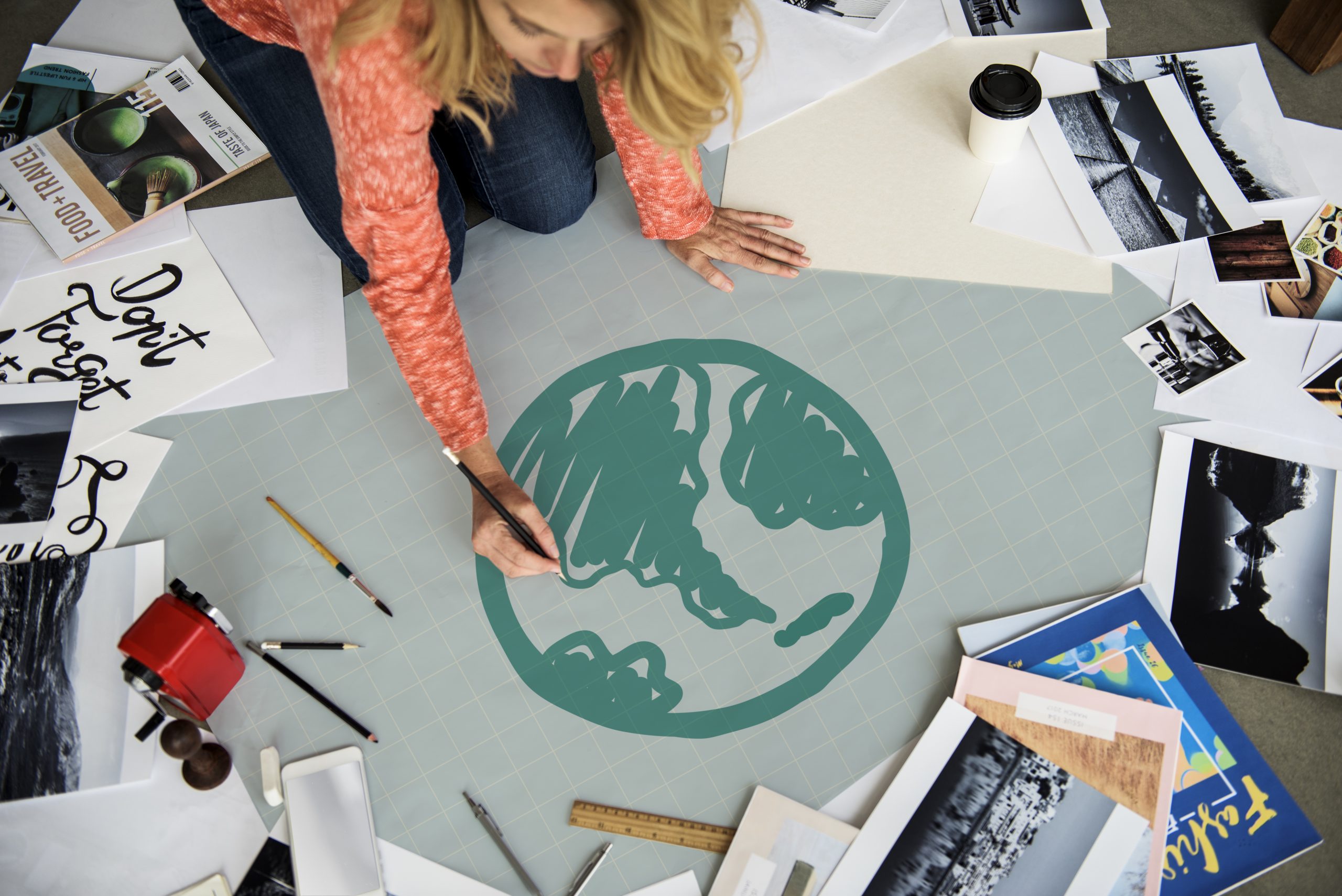Have you ever wondered how graphic design has revolutionized the world we live in? From captivating campaigns to memorable logos, graphic design has had a profound impact on our visual landscape. In this article, we’ll explore examples of how graphic design has transformed various industries and aspects of our lives. We’ll dive into the evolution of graphic design, its integration into the digital age, and its influence on visual appeal and persuasion. We’ll also discuss the growing demand for graphic design, the responsibilities of designers, and the importance of accessibility and sustainability. Prepare to be amazed as we unravel the remarkable ways graphic design has changed the world.
Evolution of Graphic Design
As you delve into the evolution of graphic design, you will discover how this field has transformed and adapted to the changing demands of the modern world. Over the years, graphic design has undergone significant changes in terms of design methods, trends, innovation, and impact. Design methods have evolved from traditional hand-drawn illustrations to digital tools and software that allow for more efficient and precise design creation. Design trends have also shifted, with new styles emerging and older ones making a comeback. Flat design, characterized by its simplicity and minimalistic approach, has gained popularity in recent years. Another trend is the use of videos in design, taking advantage of faster internet speeds to engage users and highlight offerings.
The evolution of graphic design has also been marked by design innovation. With advancements in technology, graphic designers now have access to a wide range of tools and techniques to create visually stunning and impactful designs. The introduction of three-dimensional elements in environmental graphics, for example, has created immersive settings in stores, restaurants, and office buildings. Skeuomorphism, which makes online elements look more realistic, has also influenced design by incorporating light, shadows, and textures to create a sense of realism.
The impact of graphic design cannot be overlooked. It plays a crucial role in shaping brand identity, influencing consumer behavior, and driving sales. Effective graphic design can evoke emotions, create strong connections with the audience, and enhance user experience. It is used in various fields, such as advertising, social issues, education, and environmental conservation. Graphic design has the power to simplify complex concepts, raise awareness, inspire action, and enhance learning experiences.
Application in the Digital Age
In the digital age, graphic design has expanded its application beyond printed materials and has become an essential component of websites, social media platforms, advertisements, business cards, and logos. User centric design has become a fundamental principle in the field of graphic design. Designers focus on creating experiences that prioritize the needs and preferences of the users. Interactive experiences have also become a key aspect of graphic design in the digital age. Designers strive to engage users through interactive elements such as animations, sliders, and clickable elements. Visual storytelling has gained prominence as a powerful tool in graphic design. Designers use visuals to convey narratives, evoke emotions, and captivate users. User interface design has become increasingly important as more and more people interact with digital platforms. Designers aim to create intuitive and visually appealing interfaces that enhance usability and user satisfaction. Typography trends have also evolved in the digital age. Designers experiment with different fonts, sizes, and styles to create unique and impactful designs. They pay attention to typography hierarchy, readability, and legibility to ensure effective communication. In summary, graphic design in the digital age encompasses diverse applications such as user centric design, interactive experiences, visual storytelling, user interface design, and typography trends.
Impact on Visual Appeal
Graphic design has transformed the world’s visual landscape, captivating viewers with its aesthetically pleasing designs and enhancing the overall user experience. Through the use of visual communication techniques, graphic design has greatly improved aesthetics in various mediums, from advertisements to websites, creating visually appealing designs that leave lasting impressions. By carefully selecting color palettes, typography, and imagery, graphic designers are able to create visually striking visuals that effectively convey messages and evoke emotions.
Furthermore, graphic design plays a crucial role in branding through visuals. Well-designed logos, for example, can instantly communicate the essence of a brand and help establish a strong visual identity. Consistency in design elements across different platforms and materials, such as business cards and social media profiles, also contributes to effective branding.
In addition to improving aesthetics and branding, graphic design enhances the overall user experience. Well-designed layouts and intuitive navigation make it easier for users to navigate websites and interact with digital content. By creating visually engaging designs, graphic designers are able to capture and maintain the attention of viewers, leading to a more positive user experience.
Influence on Persuasion
Graphic design has the power to shape your perception and influence your actions. Design psychology plays a crucial role in achieving this influence. By understanding how visual elements affect human cognition and emotions, graphic designers can employ persuasive techniques to effectively communicate messages. One such technique is emotional manipulation, where designers use color psychology and visual storytelling to evoke specific emotions in the viewer. For example, warm colors like red and orange can create a sense of urgency or excitement, while cool colors like blue and green can evoke feelings of calm or trust. Visual storytelling is another persuasive technique that uses images and narratives to engage the viewer and convey a message. By creating a compelling visual narrative, graphic designers can captivate the viewer’s attention and effectively communicate the desired message. These persuasive techniques in graphic design have a profound influence on our attitudes, beliefs, and behaviors, making it a powerful tool in advertising, marketing, and communication. By strategically using design elements and understanding the psychology behind them, graphic designers can shape our perceptions and guide our actions.
Growth and Demand in the Field
The field of graphic design has experienced significant growth and an increased demand for skilled designers. This growth can be attributed to technological advancements and the expanding application of graphic design to various digital mediums. As businesses recognize the importance of visual communication, the need for talented graphic designers continues to rise. This has created numerous career opportunities for individuals with a passion for design and a strong understanding of industry trends.
Technological advancements have played a crucial role in shaping the field of graphic design. The ability to create visually appealing designs using digital tools has revolutionized the creative process. Designers now have access to a wide range of software and tools that allow them to bring their ideas to life.
In addition to technological advancements, the creative process in graphic design also involves building strong client relationships. Designers must collaborate closely with clients to understand their vision and goals. This collaboration ensures that the final design meets the client’s needs and expectations.
As the field of graphic design continues to evolve, it is important for designers to stay up-to-date with industry trends. This includes keeping an eye on emerging design styles, understanding the latest software and tools, and staying informed about current design practices. By staying informed and adaptable, graphic designers can position themselves for success in this growing and dynamic field.
The table below highlights the current trends in the field of graphic design:
| Industry Trends | Career Opportunities |
|---|---|
| Minimalist design | Branding and identity design |
| Responsive design | Web and mobile app design |
| Typography experimentation | Editorial and publication design |
| Illustration and hand-drawn elements | Illustration and animation design |
| Sustainable design | Environmental and social impact design |
The growth and demand in the field of graphic design present exciting opportunities for individuals looking to pursue a career in this creative and impactful industry. With the right skills, knowledge, and a commitment to staying current, graphic designers can thrive in a field that continues to shape the way we communicate and experience the world.
Responsibilities and Impact of Designers
As a graphic designer, you have a vital role in shaping the visual landscape and influencing audience perceptions through your design choices. With this role comes great responsibility and the need to consider ethical considerations, cultural representation, social responsibility, inclusive design, and environmental impact.
Ethical considerations are essential when making design decisions. It is important to ensure that your design choices align with ethical standards and do not promote harmful or misleading messages. By being mindful of these considerations, you can contribute to a more responsible and thoughtful design practice.
Cultural representation is another crucial aspect of graphic design. Designers must be conscious of the diverse cultures and communities they are designing for. By incorporating elements that reflect and respect different cultural identities, designers can create inclusive designs that resonate with a broader audience.
Social responsibility is a key aspect of graphic design. Designers have the power to influence public opinion and shape social narratives. By using design to address social issues and promote positive change, designers can contribute to a more equitable and just society.
Inclusive design is about creating designs that are accessible to all individuals, regardless of their abilities or disabilities. Designers should strive to make their designs inclusive by considering factors such as color contrast, font size, and navigational elements. By doing so, designers can ensure that their designs are accessible to a wider audience.
Lastly, graphic designers have a responsibility to consider the environmental impact of their work. By making sustainable choices in materials, production processes, and printing methods, designers can minimize their ecological footprint and contribute to a more environmentally friendly industry.
Accessibility and Inclusivity
You play a vital role in ensuring accessibility and inclusivity in graphic design by considering the diverse needs of all individuals. Accessible design is an approach that aims to make information and products available to as many people as possible, regardless of their abilities or disabilities. Inclusive branding is another important aspect of this, which involves designing with diversity in mind and representing a wide range of people in marketing materials. Designing for disabilities involves considering the specific needs of individuals with visual, auditory, or physical impairments and creating designs that accommodate them. This can include using larger fonts, providing alt text for images, and ensuring color contrast is sufficient for those with visual impairments. Diverse representation in graphic design is crucial for creating a sense of inclusivity and promoting equality. By featuring people from different backgrounds, ethnicities, genders, and abilities in our designs, we can help to break down stereotypes and create a more inclusive society. Inclusive marketing is another important aspect of accessibility in graphic design, which involves creating campaigns that are accessible and relatable to a wide range of individuals. By considering the diverse needs of all individuals, we can create designs that are inclusive and accessible to everyone.
Sustainability in Design
Designing sustainably is essential in graphic design to minimize environmental impact and promote responsible practices. Here are four ways in which sustainability can be incorporated into graphic design:
- Sustainable practices: By adopting sustainable practices, such as reducing energy consumption, using eco-friendly materials, and implementing recycling programs, graphic designers can significantly minimize their ecological footprint.
- Eco-friendly design: Choosing eco-friendly materials and production methods is crucial in creating sustainable designs. For example, using digital platforms instead of printing on paper can help reduce waste and conserve resources.
- Minimizing ecological footprint: Graphic designers can make conscious material choices by opting for recycled or sustainable materials, such as FSC-certified paper or vegetable-based inks. These choices help minimize the negative impact on the environment.
- Teaching sustainability: It is important for graphic designers to educate themselves and others about sustainable design practices. By sharing knowledge and raising awareness, they can inspire the next generation of designers to prioritize sustainability in their work.
The Power of Graphic Design
What makes graphic design such a powerful tool for communication and influence? Graphic design has the ability to evoke emotions and create strong connections with the audience. It plays a crucial role in shaping brand identity and recognition, influencing consumer behavior, and driving sales. Effective graphic design can enhance user experience and improve usability. By incorporating elements such as color, typography, and imagery, graphic designers can create visually appealing designs that capture attention and leave a lasting impression.
Here is a table highlighting the key aspects of the power of graphic design:
| Aspects | Description |
|---|---|
| Emotional connections | Graphic design has the ability to evoke emotions and create a strong emotional connection with the audience. |
| Brand recognition | Graphic design plays a crucial role in shaping brand identity and recognition. It helps in creating a distinctive visual identity that is easily recognizable. |
| User engagement | Effective graphic design can enhance user experience and improve user engagement. Well-designed visuals and layouts can encourage users to stay longer and interact with the content. |
| Consumer behavior | Graphic design has the power to influence consumer behavior. Through strategic use of visuals and persuasive techniques, it can change attitudes, beliefs, and behaviors. |
| Usability enhancement | Graphic design plays a significant role in improving usability. Well-designed interfaces and layouts make it easier for users to navigate and interact with digital platforms. |
Graphic Design in Various Fields
Graphic design has made significant contributions across various fields. Here are some examples of how graphic design is applied in different industries:
- Graphic design in healthcare: Graphic designers play a crucial role in creating visual materials for healthcare organizations. They design informative brochures, medical illustrations, and infographics that help patients understand complex medical procedures and conditions. Their work also includes designing logos and branding materials for healthcare facilities, creating a visual identity that instills trust and professionalism.
- Graphic design in fashion: Fashion brands heavily rely on graphic design to create visually stunning advertisements, catalogs, and websites. Graphic designers work closely with fashion designers to translate their ideas into visually appealing designs. They create eye-catching logos, design patterns for fabrics, and develop visually engaging packaging for fashion products.
- Graphic design in architecture: Graphic design is essential in the field of architecture to communicate design concepts effectively. Architects collaborate with graphic designers to create visually appealing renderings, architectural diagrams, and presentations. Graphic designers also assist in developing branding materials for architecture firms, creating a cohesive visual identity that reflects their design philosophy.
- Graphic design in sports: Sports teams and organizations use graphic design to create impactful visuals that promote their brand and engage fans. Graphic designers design logos, jerseys, and promotional materials that resonate with the team’s identity. They also create visually stunning sports websites and social media graphics that capture the excitement and energy of sports.
- Graphic design in social media: In the era of social media, graphic design plays a vital role in creating visually compelling content that captures the attention of users. Graphic designers design engaging social media posts, banners, and advertisements that communicate brand messages effectively. They also create visually consistent profiles and cover images that enhance the overall aesthetics of social media accounts.



